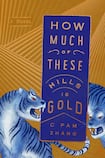
The title of C Pam Zhang’s debut novel evokes a folksy old expression, which originally comes from Mark Twain’s 1892 novel The American Claimant. But it also explicitly alludes to the Chinese experience of gold prospecting in 19th-century America. The most common Chinese name for San Francisco, Jiujinshan, means “old gold mountain”, maintaining a historical echo of the California gold rush in a city still home to one of North America’s largest Chinese populations.
How Much of These Hills Is Gold takes place across several decades either side of the rush, and tells the tale of two young daughters of Chinese migrants left to fend for themselves after their father, worn down by liquor and life in the mines, drops dead, three years after their mother has expired in childbirth.
The American west in these years was still in the process of being ideated and realised, representing a totem of new opportunity and a clean break for the many who set out there from the eastern United States and Europe. For the many Chinese who went there, it was equally a place of possibility, but also one ineffably different and alien, where the welcome was often far from hospitable.
Zhang’s novel is not quite as thematically groundbreaking as its publicity would have it. Chinese people are not completely absent from narratives of the west; Dana Hand’s Deep Creek (2010), for instance, treated the massacre of 34 Chinese miners in Oregon in 1887. How Much of These Hills Is Gold is, however, novel in the way it foregrounds Chinese women in the Old West.
The two orphaned sisters, the older Lucy and the younger Sam, have a strained relationship forged by the latter’s closeness to their late dissolute father, and the way Sam begins to dress as a boy after a much-anticipated son perishes stillborn along with their mother. Later in the novel Sam says passing as male is the only way to be taken seriously, or even of being safe, in the west.
Being Chinese in the American west is hardly safe either, with Chinese migrants increasingly marginalised and violently targeted in the America of the novel. Though it takes place in the decades preceding the infamous Chinese Exclusion Act of 1882, which outlawed Chinese immigration (Chinese women had already been barred entry in 1875), the shadow of that official interdiction hangs over the narrative.
White prospectors
At every juncture, Chinese miners are squeezed out of opportunities. In a posthumous middle section, their father, referred to simply by the Chinese moniker “Ba”, scoffs at the notion that the San Francisco gold rush began in 1848 – he recalls discovering gold as a child in the area six years earlier with his Native American mentor. However, in an echo of Columbus’s “discovery” of the Americas, he and his kind are muscled out by white prospectors of greater means. Years later, when supporting his family by mining coal, Ba finds gold but he is thwarted by an abruptly passed decree that strips non-US-born citizens of the right to prospect.
Zhang is adept at casting the structural modes of power in ordinary observations; Lucy befriends the daughter of a successful white prospector of the sort who supplanted her father in 1849. On the wall of their home is framed the very item that made his wealth possible: the deeds for prospecting. “The frame is solid gold. The deed is mere paper,” Lucy notes.
The document, ostensibly cheaper, is the more precious commodity, and, unlike gold itself, which is in theory available to all that find it, is restricted to those who fulfil the national and racial criteria. Ba and his family make occasional discoveries of gold but it can never become a sustainable source of capital for them.
Flinty realism
How Much of These Hills Is Gold is, unsurprisingly, a pessimistic work, given the historical experience of Chinese migrants in the period in question. Zhang’s well-calibrated but unfussy prose is reminiscent of both Cormac McCarthy and Toni Morrison (the latter explicitly thanked in the acknowledgements). But there is also a mystical tenor that cuts through the flinty realism, with a tiger, one of the most redoubtable animals of the Chinese zodiac, prowling throughout, an avatar of the departed mother, haunting a narrative that has at its heart an unspoken tragedy that ultimately destroys the family.
A nascent awareness of identity runs through the novel, with those identities – national, ethnic, social, gendered – shifting over the course of the book. If Zhang might be accused of endowing her novel with one flaw, it is that the notion of identity is sometimes mediated through language and ideas that are just a bit too contemporary. That said, it’s an anachronism more discursive than material and one that can be forgiven in what is otherwise a fine debut.








